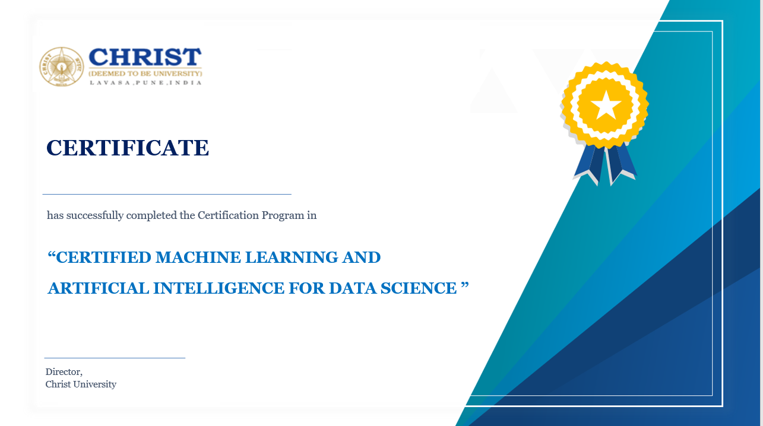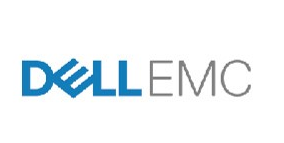
Program Duration
Duration – 3 months
Training & Practice hours 75+

Program Pedagogy
Version 1 - Online, Self-paced
Version 2 - Online, Live training

Batch Starts
Version 1 - Self-paced
Version 2 - Batch starts Jan 15, 2022
Program Highlights
-

Industry-oriented curriculum
-

Industry recognized Certifications
-

Python /R for Machine Learning
-

Machine Learning Algorithms
-

AI Technology
-

Predictive Modelling
-

Interview Preparation ML & AI roles
Program Variants
VERSION 1
SELF-PACED ONLINE
When can you take
Take anytime, Self-paced
Certification included
Microsoft Certified: Data Scientist Associate (Training included)
apply nowVERSION 2
LIVE TRAINING ONLINE
When can you take
Batch starts Jan 7, 2022
Certification included
- a.
Certificate from Christ University
- b.
Data Scientist Associate certification from Microsoft Certified (Training & Examination costs included)
SKILLS YOU WILL LEARN
Practical applied training in platforms commonly used for ML and AI
Learn practical concepts and frameworks and apply your knowledge on tools, libraries and platforms for experiential learning
-

Predictive Modelling
-

Machine Learning
-

Big Data
-

Neural Network
-

Statistical Modelling
-

Marketing Analytics
-

Financial Analytics
-

Social Media Analytics
-

Data Mining
-

NLP
-

Artificial Intelligence
-

Sentiment Analysis
-

Data Visualization
-

Deep Learning
-

Consumer Analytics
-

Supply Chain Analytics
PROGRAM OBJECTIVES
-
75+
TEACHING & PRACTICE HOURS
-
100+
APPLIED EXAMPLES PROJECTS & CODES FOR MACHINE LEARNING & ARTIFICIAL INTELLIGENCE
-
25+
AI / ML ALGORITHMS
-
15+
LEARN FROM INDUSTRY LEADERS, DOMAIN PROFESSIONALS & ACADEMIC EXPERTS
-
150+
INTERVIEW QUESTIONS ASKED FOR MACHINE LEARNING AND ARTIFICIAL INTELLIGENCE
-
24x7
ACCESS TACCESS TO LEARNING MANAGEMENT SYSTEM WITH FULLY RECORDED VIDEOS O LEARNING MANAGEMENT SYSTEM WITH FULLY RECORDED VIDEOS
YOU WILL LEARN 15+ PLATFORMS AND TOOLS USED IN MACHINE LEARNING & ARTIFICIAL INTELLIGENCE
Practical applied training in platforms commonly used for ML and AI
Learn practical concepts and frameworks and apply your knowledge on tools, libraries and platforms for experiential learning
Machine Learning and Artificial Intelligence PLATFORMS/TOOLS YOU WILL LEARN
Our Alumni at Work
WHAT JOB ROLES WILL I BE PREPARED FOR
- Machine Learning Engineer
- NLP Scientist
- Artificial Intelligence Engineer
- Cloud architect for ML
- ML AI Scientist
- Human-Centered Machine Learning Designer
- Data Scientist
- Statistician
- Big Data Engineer
- AI Data Analyst
- AI Engineer
SOME OF THE TOP COMPANIES GLOBALLY THAT RECRUIT FOR MACHINE LEARNING & AI ROLE

JUNIOR ML/AI SCIENTIST
Avg Salary
5- 10 LPA
Work Experience
0-3 years
Skills
Python, Pandas, AWS, Maths and Statistics

ASSOCIATE ML/AI SCIENTIST
Avg Salary
10- 25 LPA
Work Experience
3-5 years
Skills
Python, Pandas, AWS, R, Data Science Modeling

SENIOR ML/AI SCIENTIST
Avg Salary
25 ? 50 LPA
Work Experience
5-8 years
Skills
Python, Pandas, AWS, Tableau, Project Experience

LEAD DATA SCIENTIST
Avg Salary
35 ? 150 LPA
Work Experience
12-18 years
Skills
Python, Pandas, AWS, Tableau, Google Cloud , Project Experience, Management Skills

DIRECTOR / CTO
Avg Salary
150 LPA+
Work Experience
18+ years
Skills
Python, Pandas, AWS, R , Tableau, Google Cloud , Management Skills, Data Visualization
Program Pathway & outline
1
INTRODUCTION TO PREDICTIVE MODELLING
Learn the concepts, processes, and applications of Predictive Modeling, and their implementation in Python
2
SUPERVISED LEARNING ALGORITHMS
Learn and implement Supervised Machine Learning models including Regression, Classification, SVM algorithms
3
UNSUPERVISED LEARNING ALGORITHMS
Learn and implement Unsupervised Machine Learning models including Clustering and Neural Networking algorithms
4
AI & NEURAL NETWORKS
Learn different kinds of Artificial Intelligence algorithms including NLP, Deep Learning and Reinforcement Learning
Overview
-

Duration
"<p>15+ Teaching & Practice Hours</p>" "<p>10+ Applications to Predictive Modelling </p>"
-

Includes
"Comprehensive notes Practical examples Detailed codes Elements of Python Standard Library
"
Platform you will learn
Overview
-

Duration
"<p>30+ Teaching & Practice Hours</p>" "<p>50+ Examples and codes of Supervised Learning Algorithms</p>"
-

Includes
"Comprehensive notes Practical examples Detailed codes Use Cases Python Implementation
"
Platform you will learn
Supervised Learning ? Regression
- Linear Regression
- Logistic Regression
- Multivariate Regression
- Ridge RegressionLasso Regression
- Problems with Regression
Unsupervised Learning Algorithms
- K-means clustering.
- Hierarchal clustering.
- Anomaly detection.
- Neural Networks.
- Principle Component Analysis.
- Independent Component Analysis.
- Apriori algorithm
Supervised Learning - Classification Algorithms
- K-Nearest Neighbor
- Na?ve Bayes Classifier
- Decision Trees
- Ensemble Learning ? Bagging
- Random Forest
- Adaboost, Gradient Boost, XGBoost
- Support Vector Classifier
Linear Regression Models
- Least Square Method
- Linear Regression Using One Explanatory Variable
- Regression Table
- Regression Table with Average_Pulse as Explanatory Variable
- The Information Part in Regression Table
- The Coefficients Part in Regression Table
- Data Science - Regression Table: P-Value
- Data Science - Regression Table: R-Squared
- Data Science - Linear Regression Case Study
Polynomial Regression Models
- ML Polynomial Regression
- Need for Polynomial Regression:
- Equation of the Polynomial Regression Model:
- Implementation of Polynomial Regression using Python
- Visualizing the result for Linear regression:
- Applying Polynomial Regression to the dataset (CASE STUDY)
Logistic Regression Models
- Introduction to Logistic Regression
- What are the types of logistic regression
- What is the Sigmoid Function?
- Hypothesis Representation
- Decision Boundary
- Cost Function
- Gradient Descent
K-Nearest Neighbor
- K-Nearest Neighbor(KNN) Algorithm for Machine Learning
- Why do we need a K-NN Algorithm?
- How does K-NN work?
- How to select the value of K in the K-NN Algorithm?
- Advantages of KNN Algorithm:
- Python implementation of the KNN algorithm
Decision Trees,
- Decision Tree Algorithm
- Types of Decision Trees
- Important Terminology related to Decision Trees
- Assumptions while creating Decision Tree
- How do Decision Trees work?
- How to avoid/counter Overfitting in Decision Trees?
- Decision Tree Classifier Building in Scikit-learnDecision
Support Vector Machines
- What is Support Vector Machine?
- How does it work?
- How to implement SVM in Python and R?
- How to tune Parameters of SVM?
- Python Implementation of Support Vector Machine
- Types of SVM
- Ridge Regression
Overview
-

Duration
"<p>20+ Teaching & Practice Hours</p>" "<p>30+ Applied examples and codes with Unsupervised Learning algorithms</p>"
-

Includes
"Comprehensive notes Practical examples Detailed codes Use Cases Python Implementation
"
Platform you will learn
Neural Networks
- Multi Layer Perceptrons
- Convolutional Neural Networks
- Recurrent Neural Network
- Auto Encoder
- Generative Adversarial Network
- Graph Neural Networks
- Applications
Multi Layer Perceptron's
- Introduction
- Working on Dataset MNIST
- Building the model
- Regularization
- Activation
- Model visualization
- Evaluation
Convolutional Neural Networks
- Introduction
- Background of CNNs
- What exactly is a CNN?
- How does it work?
- What?s a pooling layer?
- Limitations
Recurrent Neural Network
- Introduction
- Why sequentially matters?
- Why having another model while we have Markov Models?
- FFNN ( Feed Forward Neural Networks ) and Backpropagation:
- Recurrent Neural Networks
- Training Recurrent Neural Networks
Generative Adversarial Network
- Introduction GAN
- GAN Libraries
- TF-GAN and Torch-GAN
- Mimicry
- Microsoft / IBM GAN toolkit
Graph Neural Networks
- Starting With Recurrent Neural Networks (RNNs)
- Reimagining Recurrent Neural Network (RNN) as a Graph Neural Neural Network (GNN)
- Non-Directed Nature of GNNs
- Applying Graph Neural Networks to Useful Inference
- A Tour of Graph Neural Network Applications
- What?s Next for Graph Neural Networks (GNNs)?
- Quantum Graph Neural Networks (QGNNs)
- Bringing GNNs Into the Future
Overview
-

Duration
"<p>20+ Teaching & Practice Hours</p>" "<p>20+ Application from various domain in Artificial Intelligence AI strategy</p>"
-

Includes
"Comprehensive notes Practical examples Detailed codes Use Cases Python Implementation
"
Platform you will learn
Importance of Predictive Modelling in Data Science and Analytics
- Predictive Modeling introduction
- Common tool s and platforms for Predictive Modelling
- Types of Predictive Modelling algorithms
- Can you Predict the Stock Market?
- R vs Python for Predictive Modelling
- Model Validation ? Training and Testing
- Lifecycle of Model Building
- Applications of Predictive Modelling
Introduction To Artificial Intelligence
- What is Artificial Intelligence AI
- Emergence of AI
- AI in Practice
- Relationship between Artificial Intelligence, Machine Learning, and Data Science
Practical considerations for Predictive Modelling
- Understand Business Objective
- Analyze and Transform Variables. Random Sampling
- Model Selection and Develop Models (Training)
- Validate Models (Testing), Optimize and Profitability
- Document Methodology and Models
- Implement Models and UAT
- Monitoring and Performance Tracking
- How good is your model
- Choosing between models
Natural Language Processing
- Perform sentiment analysis of tweets
- Classify positive or negative sentiment in tweets using NLP
- Relationships between words using AI
- Translation algorithms and associations
- Implement Auto-correct using distance algorithms
- Implement Auto-complete using N-gram algorithms
- Train Neural networks to perform Named Entity recognition using LTSM algorithms
- Applied examples of Lexical Processing
- Applied examples of Syntactic Processing
Data Exploration for Predictive Modelling
- Data Exploration Tools
- Why is Data Exploration Important?
- What is Exploratory Data Analysis?
- Data Exploration in GIS
- Data Exploration in Machine Learning
- Interactive Data Exploration
- What is the Best Language for Data Exploration?
- Data Exploration in Python
- Data Exploration in R
Deep Learning
- Syntactic Processing
- Neural Networks and Deep Learning
- Convolutional Neural Networks -Industry Applications
- Recurrent Neural Networks and applications
- Classical Reinforcement Learning
- Deep Reinforcement
Investment for the Program
VERSION 1 SELF-PACED ONLINE
-
Financing Options
Microsoft Certified: Data Scientist Associate (Training included)
-
When can you take
Take anytime, Self-paced
VERSION 2 LIVE TRAINING ONLINE
-
Financing Options
- a.
Certificate from Christ University
- b.
Data Scientist Associate certification from Microsoft Certified (Training & Examination costs included)
- a.
-
When can you take
Batch starts Jan 7, 2022
Frequently asked question's about the course
A Machine Learning Engineer is an engineer (duh!) that runs various machine learning experiments using programming languages such as Python, Java, Scala, etc. with the appropriate machine learning libraries. Some of the major skills required for this are Programming, Probability, and Statistics, Data Modeling, Machine Learning Algorithms, System Design, etc.
Data Scientist analyzes data in order to produce actionable insights. These are then used to make business decisions by the company executives. On the other hand, a Machine Learning Engineer also analyzes data to create various machine learning algorithms that run autonomously with minimal human supervision. In simpler words, a Data Scientist creates the required outputs for humans while a Machine Learning Engineer creates them for machines (Hopefully very smart ones!!!).
NLP stands for Natural language processing and it involves giving machines the ability to understand human language. This means that machines can eventually talk with humans in our own language(Need a friend to talk to Talk with your machine!).
So, an NLP Scientist basically helps in the creation of a machine that can learn patterns of speech and also translate spoken words into other languages. This means that the NLP Scientist should be fluent in the syntax, spelling, and grammar of at least one language in addition to machine learning so that a machine can acquire the same skills.
There are several important Job Roles in Data Science most important one are:
It is not required to have a Programming background, although desirable. However, those without Programming background will undergo Pre-requisite training on Programming to accelerate the learning when the Program begins.
Skills Required:
VERSION 1 SELF-PACED ONLINE
When can you take
Take anytime, Self-paced
Certification included
Microsoft Certified: Data Scientist Associate(Training included)
Apply now
VERSION 2 LIVE TRAINING ONLINE
When can you take
Batch starts Jan 7, 2022
Certification included
A A Certificate from Christ University
B Data Scientist Associate certification from Microsoft Certified (Training & Examination costs included)
Apply now
Peer networking
In addition to the training program, you will have ample opportunity to network with the peers in your cohort. Prior to coming to the program, you will have access to your cohort where you can meet and engage with your peers before, during, and after the program.
Industry networking
Throughout the program, you will be taught and mentored by Machine Learning & Data Scientists working/having worked with leading companies.
Alumni networking
Besides, after the program, you will be invited to join the Ml and AI Alumni group.
Placement Leads
We have networks with leading industry participants including banks, financial institutions, consulting firms and analytics firms; you can leverage that network for connecting with the industry and finding suitable opportunities in ML and AI . Once you are trained and ready, we will help you with placement leads that can help you land your dream role in ML and AI.
Having said that, its entirely your performance and skill-sets that will define your journey in landing your dream job. We cannot guarantee that you will get a job after completing the program. Obtaining a job is strictly based off one s own skill sets. Upon completion of the program, we will provide you with a certificate that you can print and/or add to your LinkedIn profile.
Networking opportunities
You will have great networking opportunities at the program. Our industry faculty work in the industry in leading positions and that will provide a great opportunity for you to network. Besides, EduEdgePro, through its vast industry network, will help you reach out to the leading financial firms for placements.
Yes, this is an online program.
There are 2 versions































































